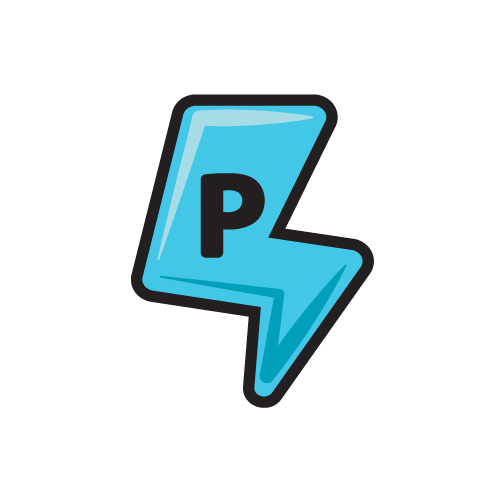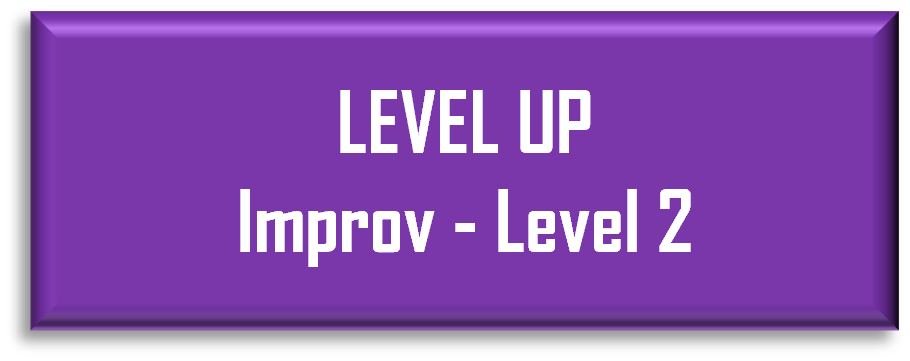
Improv - Level 1
In this level, you will learn about offers in improv and how to recognize, make, accept and advance offers! The final challenge will be to showcase an improvised monologue using various prompts.
On your journey to tackle the Final Challenge and complete the Level, you will need to earn 1 Power Up and gain 3 Experience Points along the way.

In this level, you will:
- Power Up by discovering what offers are and how to recognize them
- Gain Experience by practicing making offers
- Gain Experience by practicing accepting and advancing offers
- Gain Experience by learning about concluding a scene
- Take on the Final Challenge by improvising a monologue incorporating random prompts
This Level Up Challenge is based on a unit designed and developed by student Thespians.
POWER UP: Learn about Offers

According to ImproWiki, an offer is "an activity or a comment of a player, which refers to a teammate or is directed at him, and requires a gestural/mimed or verbal response."
To put it simply, it is an idea that one player suggests. By making an offer, Player A is introducing a new idea or direction in which the scene will go. By accepting the offer, Player B will say "yes" to the offer and thus bring the idea into play. But simply accepting an offer is not enough, it is necessary for Player B to advance said offer to cement its place in the scene. After all of that, the players will find a way to efficiently end the scene with a conclusion related to the scene.
In the Canadian Improv Games, the best event to show how offers are made is the "Theme" event where teams quickly go through vignettes of short scenes. In most cases, the first person to change the scene to a new one is the one making an offer.
To see an example, take a look at the short scene at 0:47 in this theme event (source: Canadian Improv Games). In the video, one player initiates a non-verbal offer, followed up by a simple verbal statement saying he's hungry. Everyone accepts the offer by becoming birds themselves. Another player advances the offer by saying there's no food in the sky and it is concluded by solving the problem (in this case, by going to the old man's house which has food).

TO POWER UP: Watch the video recording below of a team participating in this event. While watching, identify the following in the scenes:
- The offer made
- The accepting party and what the advancement was
- The conclusion
Epilepsy warning: flashing/strobing lights. Strobe ends at 0:24, and begins again at 4:28. Click here to watch a performance from this event (source: Canadian Improv Games.)
GAIN EXPERIENCE: Practice Making Offers

Now that you can recognize when an offer is made, accepted and advanced and then concluded, it is time for you to make your own! Watch this quick video (source: Canadian Improv Games) to learn more about how to make offers.
To make an offer is to bring a new idea to the table. In order for a scene to start, an offer needs to be made. This can be a verbal offer or a non-verbal action. An offer can be anything, an object, a general statement, a theme, the start of an action, something you and your scene partner can work with. Since this is a solo challenge, the activity will be the scene partner. Now your time to shine!

TO GAIN EXPERIENCE: Practice coming up with 5 different offers (Verbal, or nonverbal) inspired by 5 random prompts. You can have a friend give you 5 random words to use as prompts, or use a website like www.can-i-get-a.com and hit the "word" button five times. Your offers can be anything, as long as they are related in some way to the prompts. Keep practicing until you can make 5 different offers in less than 30 seconds!
GAIN EXPERIENCE: Practice Accepting and Advancing Offers

According to Improv.ca: "If offers are the building blocks of improvisation, accepting is how we put them to use". Accepting offers is simple in theory, but in actual practice will take some time getting used to. In life, we are used to rejecting ideas we are not comfortable or familiar with. In improvisation, we do not have the option of saying "no". If we reject an offer by saying no, it is called blocking and the scene stops cold in its tracks. Watch this video to learn more about how to accept offers (source: Canadian Improv Games).
Now that you've accepted that gigantic pink mice are falling from the sky, what now? Now is the time to advance the scene! Advancing a scene is akin to accepting an offer and making an offer at the same time. You build off of the original idea and say "yes, and..." to introduce more information! Your goal here is to add more to the scene. Take a look at this video to learn how to advance offers (source: Canadian Improv Games).

TO GAIN EXPEREINCE: Use a random number generator to give you 3 numbers between 1 to 45 (or have a friend give you 3 numbers between 1 and 45). Then, open this document and locate the three random prompts that match the three numbers you were given by the number generator.
Your job is to accept the offer given to you in each of these randomly generated statements, then advance it by introducing a new idea within 10 seconds. Repeat this for each prompt you were given (for a total of 3 times). Your goal is to introduce a concrete new idea related to the generated statement within 10 seconds (per prompt for a total of 30 seconds). Your offers can be anything as long as they are related in some way to the prompts. Good luck!
GAIN EXPERIENCE: Practice Concluding a Scene

The art of the ending is a difficult one indeed. People often neglect how much an ending matters. Some general rules are that you stick to your original offer or something related to your original offer, and that you end the scene when it is dying or stagnating.
Watch this video of a team competing in the STORY event at the Canadian Improv Games and pay attention to how they end their scene (source: Canadian Improv Games).

For this activity, you will be asked to come up with creative solutions to every day problems using random objects. You will be given a random day-to-day problem (ex. tripping over shoelaces, forgot to do the dishes, drank expired milk, forgot to lock the door, clicked on the wrong link, etc.), and a random object. You will to come up with a solution for the problem using the object. See below for some examples:
Problem: Tripping over shoelaces
Object: Stapler
Solution: Stapling the shoelaces to the side of the shoes.
Problem: forgot the lock the door
Object: Teddy bear
Solution: Send the teddy bear back to guard the door. (They have sentience, I know it!)
Problem: Drank expired milk
Object: Umbrella
Solution: sticks the umbrella down the throat, opens it to widen the esophagus and pours the milk back out.
TO GAIN EXPERIENCE: You will be given 3 random problems and 3 random objects, and you will need to come up with a solution for your first problem using the first object, then repeat this twice more with the other problems and objects. Your goal will be to come up with a solution to the problem using the object for each prompt (a total of 3 times) in under 30 seconds.
To receive your randomly generated problems and objects, use a random number generator to give you 3 numbers between 1 to 20 and 3 numbers between 21 to 40 (or have a friend give you 3 numbers between 1-20 and 3 numbers between 21-40). Then, open this document and locate the three problems and the three objects that match the six numbers you were given by the number generator. Good luck!
FINAL CHALLENGE: “Mad Monologue Mayhem!”


During this journey, you powered up by discovering offers in improv and how to recognize them. You also gained experience by practicing making offers, accepting/advancing offers, and concluding scenes. Now, using the power up and experience points you gained along the way, you are ready take on the final challenge: "Mad Monologue Mayhem!"
TO COMPLETE THE FINAL CHALLENGE: Improvise a full monologue that lasts at least one minute using 5 random prompts. Be sure to work all the prompts into the monologue, while also coming up with a start that is unrelated to all the prompts. This will require you to make an initial offer, accept and advance offers given by the random prompts, then conclude the monologue. You can have a friend give you 5 random words to use as prompts, or use a website like www.can-i-get-a.com and hit the "word" button five times.
| Access Date | Quiz Result | Score | Actions |
|---|
Learning Center
- Webinars
- Adjudication Trainings
- Featured Courses
- Full Course List
- Lesson Plan Library
- Click to Teach Interactive Online Lessons
- Resources for New Theatre Teachers
- Technical Theatre Educator's Manual
- Connected Arts Networks
- Diverse Resources for Theatre Education
- Behind the Scenes Technical Theatre Curriculum
- Social & Emotional Learning
- Additional Standards Based Instructional Resources
- Search the Catalog
- Cart (0 items)
Full Site Search
Membership Benefits
Join EdTA for full access to our professional development and standards-based teaching resources, including:
- 300+ lesson plans
- Click to Teach online lessons
- K-12 curriculum
- Webinars
- And more!




